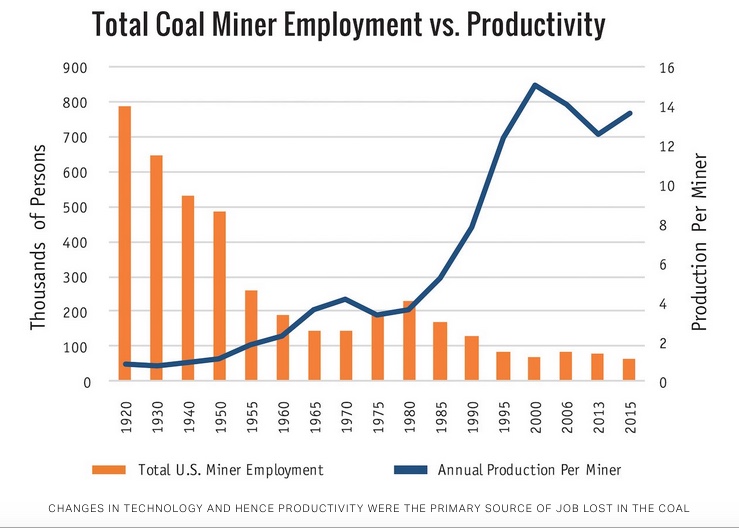Bringing back coal jobs is ‘about as practical as bringing back the buggy whip industry’, explains Krugman.

Nobel Prize-winning economist Paul Krugman speaks at the Challenges of Job-Rich and Inclusive Growth – Session 2: Public debt, public investment, and growth talk at George Washington University in Washington,DC on October 8, 2014 at the start of the annual IMF/World Bank meetings. AFP PHOTO/Nicholas KAMM (Photo credit should read NICHOLAS KAMM/AFP/Getty Images)
In an exclusive interview, Nobel Prize winning economist Paul Krugman explained to ThinkProgress why “coal is not coming back,” despite President Trump’s promises to the contrary. Krugman described Trump’s efforts to “desperately force clean energy to subsidize dirty energy” as “bad economic policy.”
The vast majority of the jobs were lost to technology, Krugman explained in an interview with ThinkProgress, which followed his remarks Tuesday morning at the 2018 Ideas Conference of the Center for American Progress. Note 1. (Disclosure: ThinkProgress is an editorially independent news site housed at the Center for American Progress where Romm has been a Senior Fellow for the past decade.)
“Coal consumption was flat until about 10 years ago,” Krugman notes, “But coal jobs, most of them disappeared anyway because of instead of sending men with picks underground, we were blowing the tops off mountains. It was mostly technology.”
Starting around 1980, rapid productivity gains driven by technology slashed U.S. coal mine jobs by two thirds. Note 2. Strangely, we never hear about Ronald Reagan’s war on coal. Note 3.

Changes in technology and hence productivity were the primary source of job lost in the coal industry since 1980s. CREDIT: Third Way
In the past decade, fracking hit coal hard, Krugman said, “and now finally clean energy has come along.”
“Solar and wind basically out-compete coal-fired power now even without any public policy to make them do that,” he added. “There are way more people now who are employed in solar than there are in coal.”
“So, coal is not coming back,” he said. “The question should be what can we do for what used to be coal country — not what can we do to bring coal jobs back, because that’s about as practical as bringing back the buggy whip industry.”
The Trump team, however, is focused on the buggy whips, as Energy Secretary Rick Perry comes up with one dubious subsidy plan after another. Note 4.
Meanwhile, more coal capacity was retired in the first 45 days of 2018 than in any of the first three years of the Obama administration. Note 5. And top energy-industry analysts project a much faster pace of coal plant retirements in the coming years than they did just a year ago. As one analyst explained last week, “the economics of coal have gotten worse” under Trump Note 6.

Under Trump, coal’s rate of collapse to be ‘more than twice’ what analysts previously projected
“At this point, we flipped completely from trying to make arguments for subsidizing clean energy to a situation where the Trump administration and its friends are trying to desperately force clean energy to subsidize dirty energy,” notes Krugman. “And so even if you ignore the environmental impacts, that’s a bad economic policy.”
But, as Krugman points out, you can’t ignore the environmental impacts. “Clean energy is the future. And climate change is real, which means that there is a reason to bring on that future as quickly as possible.”
A rapid switch to clean energy is “not just a jobs issue,” he said, “because the fate of the planet is also on the line.”
Notes
Note 1. capideas.org/
Note 2. Matt Goldberg, “Digging Himself Into a Hole: Trump’s Empty Coal Promises,” Third Way. bit.ly/2GoGK8y
Note 3. Joe Romm, “Krugman: In The Real War On Coal, The Mining Industry Won And Workers Lost,” thinkprogress (9 June 2014). bit.ly/2Gmbx67
Note 4. Joe Romm, “Rick Perry’s plan to make taxpayers bail out coal and nuclear rejected by federal agency,” thinkprogress (8 January 2018). bit.ly/2rMBtTG; and, Mark Hand, “After subsidy proposal fails, Rick Perry uses ‘bomb cyclone’ to promote coal generation,” thinkprogress (28 March 2018). bit.ly/2wIuD6U
Note 5. Joe Romm, “Reality sets in for the coal industry: Trump is powerless to save it,” thinkprogress (22 Feb 2018). bit.ly/2HGw8nA
Note 6. Joe Romm, “Under Trump, coal’s rate of collapse to be ‘more than twice’ what analysts previously projected,” thinkprogress (9 May 2018). bit.ly/2wL7G2S
Originally published in thinkprogress (15 May 2018) at bit.ly/2rLqFp6
Joseph Romm, Ph.D., is one of the United States’ most influential communicators on climate science and solutions. Romm is Chief Science Advisor for “Years of Living Dangerously,” which won the 2014 Emmy Award for Outstanding Nonfiction Series. He is the founding editor of Climate Progress, which New York Times columnist Tom Friedman called “the indispensable blog.” In 2009, Time named him one of its “Heroes of the Environment,” calling him “The Web’s most influential climate-change blogger.” In 2009, Rolling Stone put Romm on its list of 100 “people who are reinventing America.” Romm was acting assistant secretary of energy in 1997, where he oversaw $1 billion in low-carbon technology development and deployment. He is a Senior Fellow at American Progress and holds a Ph.D. in physics from MIT.
Dr. Romm is also author of Climate Change: What Everyone Needs to Know (Oxford University Press, 2015). amzn.to/2J8L1iG
“Climate Change, What Everyone Needs to Know is a must-read for those who want to become climate literate and join the growing conversation about the greatest threat humanity faces today.” –The Guardian


No comments yet, add your own below